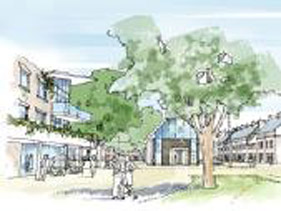Is sustainable tourism an eco-nundrum

St Austell as it may look
Or are transportation emissions the only Elephant in the Room
In an article in this week’s Financial Times Graham Norwood wrote: “From villages to resorts, projects claiming green credentials face a clash between principles and practicalities”
He continued:
Visiting the part of the UK where this is happening– six sites adding up to 700ha in the Cornish port of St Austell, 270 miles south-west of London – it is easy to be impressed. Waste mountains of clay will be flattened, a lunar landscape of exhausted mines and quarries will be manicured and derelict industrial units demolished.
In their place will be an eco-community, “an example of sustainable living in the 21st century” with more than a third of the homes designated as affordable for local people, two-thirds of the land turned into open spaces, a “vibrant marina and waterside development”, a green transport hub and thousands of jobs to which locals should be able to walk or cycle.
“There’s a cable car being considered to link some of the surrounding tourist facilities and there will be adventure sports too, along with walking and cycle paths, and it will all be created almost entirely by local labour and using local materials,” says a spokesman for Eco-Bos, the developer working on the scheme with china clay producer Imerys.
And yet, and yet – the ambition is faultless but in reality, how sustainable is the Eco-Bos dream?
In the UK, according to the Office of National Statistics, 76 per cent of workers outside London commute by car. In Cornwall, a rural area with buses and trains often described as expensive, infrequent and not even reaching some villages, the proportion is still higher. Are people in the St Austell eco-community going to buck that trend and use public transport while all around them car use is increasing?
More than 6 per cent of Cornwall’s housing is holiday homes, owned by outsiders and occupied for a minority of the year, to the annoyance of some locals. In pockets near the coastline, four out of five houses are holiday homes. Will the St Austell scheme, which promotes a “waterside culture” and 500-plus apartments on three sides of an opulent marina, really be able to avoid the same thing happening?
And those tourists buying tickets for the cable cars – how will they arrive in south-west England? The Eden Project, an ecological theme park 2 miles away, has 1.2m visitors per year, of which less than 15 per cent arrive by any means other than private car.
The St Austell proposal goes to local authorities for approval this winter. Some local homeowners have campaigned in protest, arguing that – among other things – a development scheduled to involve up to 30 years of construction work is hardly an environmentally-friendly initiative for those already living in the area.
Debates of this kind are happening across the world where conflicts arise between noble objectives and practicalities. The arguments are sharper in the case of luxury holiday resorts, many of which now claim green credentials.
For example, Port Ghalib on Egypt’s Red Sea riviera is part of a $2bn project for 600 residences, four hotels and a marina with berths for 1,000 yachts.
“We take very seriously our responsibility to minimise the impact,” says Ibrahim Saleh, vice-president of the developer, Kharafi Group. “Our commitment to ensure 20 per cent of the energy used by the resort is generated from renewable and clean sources is testament to this. We’re investing over $700m in state-of-the-art infrastructure such as wind turbines and solar panels to achieve this target and hope this will help our guests enjoy their stay here with a clear conscience.”
Yet the resort is marketed in France, Germany, Italy, Russia, the UK and Ireland, and publicity material boasts of direct flights from London, Paris, Berlin, Rome, Beirut, Kuwait, Dubai and Jeddah. The contradictions are clear.
Medina Palms at Watamu in Kenya, a community of private residences on the fringe of a marine park, will be completed next year and will include a bio-digester, waste and water recycling units and “a sustainable transport policy” – electric buggies, bicycles and tuk-tuks. Yet to get there, even after the flight to Nairobi, you must take a hefty gas-guzzling, carbon-producing drive of up to two hours.
Or look at Soneva Kiri, a resort run by Six Senses on the Thai island of Koh Hood. It has won green awards yet to get there you fly to Bangkok, take a one-hour connecting flight and then, as the promotional material puts it, “it’s just 2km by speedboat”. It would take a lot of carbon-offsetting to arrive with your green credentials intact.
Many experts, however, do not condemn such schemes as hypocritical: quite the reverse. They argue that while these developments may be doomed to some degree of failure on an environmental basis, at least most try to address climate change and reconcile practicalities with principles.
“It’s the so-called ‘Wicked Problem’,” says sustainability expert Professor David Strong, referring to the conundrum of solving a problem which has no definite shape and about which information is constantly changing.
“Sustainability for much of the world would be achieved by guaranteeing access to drinking water. In the west, by contrast, sustainability means something very different – from country to country and even within different localities,” he says. “In a developed country, 70 per cent of the homes that will exist in 2050 – a time horizon used by many authorities – have already been built. So making new homes sustainable in the future is fine, but hardly scratches the surface of how we live sustainably in older homes. Nevertheless, it’s better to try and have contradictions and inconsistencies than not to try at all.”
The marketing benefits of being seen to be green have led to the creation of Sustain Worldwide, a body for developers to “create a benchmark for environmental and socially responsible residential development worldwide”. Members pay an annual fee to join and display its branding on their publicity material and advertisements.
Chief executive Anwar Harland Khan – who is developing a Moroccan resort – says SW “will motivate the property-buying public to consider eco-properties” and claims the 11 founding members’ developments have a combined sales value of £3.5bn and created 35,000 jobs through their construction and operation.
Yet many believe the most successful attempts to build truly sustainable communities have not necessarily been those that have shouted loudest.
The Orestad suburb of the Danish capital, Copenhagen, has made few headlines but is regarded as a success by environmental specialists, such as those running the United Nations Environment Programme. The 20-year build project will include homes and work units, while rainwater is syphoned to fill the canals that run beneath the monorail service. Yet the local shopping centre – Fields, one of northern Europe’s largest malls – has occupiers like Burger King and Sony to remind us that even here the less sustainable world is close at hand.
Just 600 miles away is another sustainable community, the 5,000-person Vauban suburb built on the site of a disused airbase in the German city of Freiburg. The homes are built around rigorous energy-saving Passivhaus principles, 70 per cent of households have no private transport aside from bicycles, and those with cars pay a high annual fee to park in a communal “solar storage” block.
Yet here, too, there are downsides. A visiting journalist from a newspaper sympathetic to the town’s ecological principles discovered that wind turbines were constrained from operating at maximum efficiency to avoid killing bats, that car-free families were sometimes stuck in their homes due to tram strikes, and expressed concern about private developers building homes and changing the nature of the area.
Those behind the UK’s proposed eco-community in Cornwall may face the same tensions in the coming years as they attempt to reconcile their hopes with everyday life. Sustainability, it seems, is a noble objective that is easy to support. Achieving it, however, is a good deal more difficult.
Sustainable Tourism Report Suite 2011 Get your copy at a special offer price: HERE
 United Kingdom
United Kingdom United States
United States Asia Pacific
Asia Pacific












































Dozens fall ill in P&O Cruises ship outbreak
Turkish Airlines flight in emergency landing after pilot dies
Boy falls to death on cruise ship
Unexpected wave rocks cruise ship
Woman dies after going overboard in English Channel